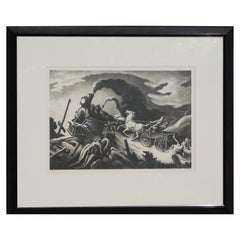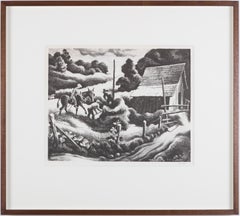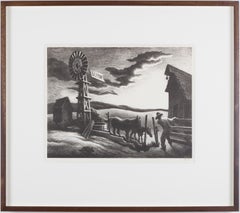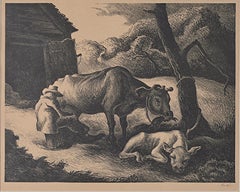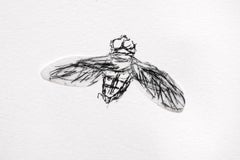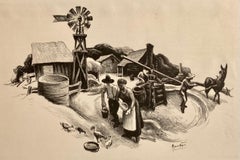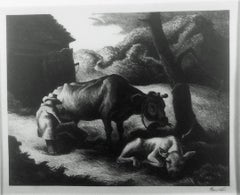Thomas Hart Benton Animal Prints
American, 1889-1975
Thomas Hart Benton was born in Neosho, Missouri on April 15, 1889. Even as a boy, he was no stranger to the "art of the deal" or to the smoke-filled rooms in which such deals were often consummated. His grandfather had been Missouri's first United States Senator and served in Washington for thirty years. His father, Maecenas Benton, was United States Attorney for the Western District of Missouri under Cleveland and served in the United States House of Representatives during the McKinley and Theodore Roosevelt administrations. Benton's brother, Nat, was prosecutor for Greene County, Missouri, during the 1930s.
As soon as he could walk, Benton traveled with his father on political tours. There he learned the arts of chewing and smoking, and while the men were involved in their heated discussions, Benton delighted in finding new cream colored wallpaper on the staircase wall, at the age of six or seven, and drew in charcoal his first mural, a long multi-car freight train.
As soon as he was eighteen, even though his father wanted him to study law, Benton left for Chicago where he studied at the Art Institute during the years 1907 and 1908. He continued his studies in Paris, where he learned delicious wickedness, aesthetic and otherwise.
Once back home, he became the leader of the Regionalist School, the most theatrical and gifted of the 1930s muralists and as Harry Truman described him,"the best damned painter in America."
Detractors said that Benton was "a fascist, a communist, a racist and a bigot"; the ingenious structure, powerful use of modeling and scale and the high-colored humanity of the murals and easel paintings are retort enough. He was a dark, active dynamo, only 5 ft., 3 1/2 in. tall. He was outspoken, open, charmingly profane; he had a great mane of hair and a face the texture of oak bark. He wore rumpled corduroy and flannel, and walked with the unsteady swagger of a sailor just ashore. He poured a salwart drink, chewed on small black cigars and spat in the fire.
Benton was once described as the "churlish dean of regionalist art." If you listened to a variety of art authorities, you would find them equally divided between Harry Truman's assessment of Benton as "the best damned painter in America" and Hilton Kramer who proclaimed Benton "a failed artist."
The East Coast art establishment tended to regard Benton as memorable for one reason only: he was the teacher of Jackson Pollock.
Benton was married in 1922 to Rita, a gregarious Italian lady, and they had a daughter and a son. At the height of his fame in the 1940s, Benton bungled the buy-out he was offered by Walt Disney and went his own way, completing his last mural in 1975 in acrylics the year of his death.
He died in 1975.to
4
Overall Width
to
Overall Height
to
3
22
196
164
100
95
4
1
2
4
4
2
2
2
1
1
1
1
1
1
1
4
1
2
2
2
Artist: Thomas Hart Benton
Thomas Hart Benton Original Lithograph, 1944 - Wreck of the Ol’ ‘97
By Thomas Hart Benton
Located in Phoenix, AZ
Original stone lithograph created 1944 by well-known Regionalist Thomas Hart Benton.
The print is in excellent condition with full margins and pencil signed lower right. Also signed in the stone.
It is matted in a 4-ply archival mat and rests in a simple black frame.
Image size: 10 ½ x 15. Frame size: 18 x 23. Published by AAA. Ed: 250.
Thomas Hart Benton found inspiration for his art in the ebb and flow of daily life in rural and small-town America. Wreck of the Ol’ 97, one of his best-known prints, is based on a ballad of the same title that tells the story of a rail disaster. A speeding locomotive attempting to make up lost time jumped the tracks as it descended a Virginia mountain...
Category
Mid-20th Century Thomas Hart Benton Animal Prints
Materials
Paper, Lithograph
Haystack
By Thomas Hart Benton
Located in London, GB
A fine impression of this very popular image with full margins (smaller on top and bottom) published by Associated American Artists.
Category
1930s American Modern Thomas Hart Benton Animal Prints
Materials
Lithograph
Nebraska Evening
By Thomas Hart Benton
Located in London, GB
A fine impression with good margins published by Associated American Artists.
Category
1940s American Modern Thomas Hart Benton Animal Prints
Materials
Lithograph
"White Calf, " Farm Genre Scene Original Lithograph by Thomas Hart Benton
By Thomas Hart Benton
Located in Milwaukee, WI
"White Calf" is an original lithograph print by Thomas Hart benton. It features the image of a man milking a cow while her calf lays down in front. Benton's breathtaking way of rende...
Category
1940s American Modern Thomas Hart Benton Animal Prints
Materials
Lithograph
Related Items
Meditation and Minou
By Will Barnet
Located in Buffalo, NY
Artist: Will Barnet, American (1911 - 2012)
Title: Meditation and Minou
Year: 1980
Medium: Lithograph and Serigraph on BFK Rives, signed and numbered in pencil
Edition: 40/150
Category
1970s American Realist Thomas Hart Benton Animal Prints
Materials
Archival Paper, Lithograph
Kiki Smith Lithograph/Collage Various Flying Creatures "bee" Signed Dated
By Kiki Smith
Located in Detroit, MI
A collage lithograph from her series Various Flying Creatures by Kiki Smith titled: "bee." Smith has used one of her animal/insect iconic figures for this glassine paper and wove pap...
Category
1990s American Modern Thomas Hart Benton Animal Prints
Materials
Paper, Lithograph
$1,500
H 19.75 in W 16.5 in
Horses in Moonlight, Folk Art Equestrian Lithograph by Lebadang
By Hoi Lebadang
Located in Long Island City, NY
Artist: Lebadang, Vietnamese (1922 - 2015)
Title: Horses in Moonlight
Year: circa 1975
Medium: Lithograph, signed in pencil
Edition: Epreuve d'Artiste
Size: 25.25 x 19.5 in. (64.14 x...
Category
1970s Modern Thomas Hart Benton Animal Prints
Materials
Lithograph
$480 Sale Price
20% Off
H 25.25 in W 19.5 in
Original New Orleans Jazz & Heritage Festival vintage poster
Located in Spokane, WA
Original, Linen backed New Orleans Jazz & Heritage Festival poster from 1983. A fun image with a crawfish holding an umbrella with streamers. 1983 JAZZ & HERITAGE FESTIVAL PRO-MO ...
Category
1980s American Modern Thomas Hart Benton Animal Prints
Materials
Offset
$498
H 29.25 in W 17.25 in
Alexander Calder Circus Reproduction Lithograph After a Drawing
By (after) Alexander Calder
Located in Surfside, FL
(after) Alexander Calder
"Calder's Circus" offset lithograph on wove paper after drawings by the artist
Published by Art in America and Perls gallery in 1964 (from drawings done in the 1930's)
these range slightly in size but they are all about 13 X 17 inches (with minor variations in size as issued.) These have never been framed. The outer folio is not included just the one lithograph.
James Sweeny from the introduction “The fame of Calder’s circus spread quickly between the years 1927 and 1930. All the Paris art world came to know it. It brought him his first great personal success. But what was more important, the circus also provided the first steps in Calder’s development as an original sculptor”
Clive Gray wrote ”A visit to the studio of Alexander Calder led to the chance discovery of some hundred masterful circus drawings completed over thirty years ago. We publish, for the first time, a choice of sixteen from that group.” With signed introduction by Miro.
These whimsical drawings, done in the style of wire sculpture, include acrobats, clowns, jugglers, trapeeze artists, an elephant, dog and lion. they are great.
Alexander Calder is widely considered to be one of the most important American sculptors of the 20th century. He is best known for his colorful, whimsical abstract public sculptures and his innovative mobiles, kinetic sculptures powered by motors or air currents, which embraced chance in their aesthetic. Born into a family of accomplished artists, Calder's work first gained attention in Paris in the 1930s and was soon championed by the Museum of Modern Art in New York, resulting in a retrospective exhibition in 1943. Major retrospectives were also held at the Solomon R. Guggenheim Museum (1964) and the Museum of Contemporary Art, Chicago (1974). Calder’s work is in many permanent collections, most notably in the Whitney Museum of American Art, but also the Guggenheim Museum; the Museum of Modern Art; the National Gallery of Art, Washington, D.C.; and the Centre Georges Pompidou. He produced many large public works, including .125 (at JFK Airport, 1957), Pittsburgh (Carnegie International prize winner 1958, Pittsburgh International Airport) Spirale (UNESCO in Paris, 1958), Flamingo and Universe (both in Chicago, 1974), and Mountains and Clouds (Hart Senate Office Building, Washington, D.C., 1976). Although primarily known for his sculpture, Calder was a prodigious artist with a restless creative spirit, whose diverse practice included painting and printmaking, miniatures (such as his famous Cirque Calder), children’s book illustrations, theater set design, jewelry design, tapestry and rug works, and political posters. Calder was honored by the US Postal Service with a set of five 32-cent stamps in 1998, and received the Presidential Medal of Freedom, posthumously in 1977, after refusing to receive it from Gerald Ford one year earlier in protest of the Vietnam War.
Calder moved to New York and enrolled at the Art Students League, studying briefly with Thomas Hart Benton, George Luks, Kenneth Hayes Miller, and John Sloan. While a student, he worked for the National Police Gazette where, in 1925, one of his assignments was sketching the Ringling Bros. and Barnum & Bailey Circus. Calder became fascinated with the action of the circus, a theme that would reappear in his later work.
In 1926, Calder moved to Paris, enrolled in the Académie de la Grande Chaumière, and established a studio at 22 rue Daguerre in the Montparnasse Quarter. In June 1929, while traveling by boat from Paris to New York, Calder met his future wife, Louisa James (1905-1996), grandniece of author Henry James and philosopher William James. They married in 1931. While in Paris, Calder met and became friends with a number of avant-garde artists, including Fernand Léger, Jean Arp, and Marcel Duchamp. Cirque Calder (on view at the Whitney Museum of American Art at present) became popular with the Parisian avant-garde. He also invented wire sculpture, or "drawing in space," and in 1929 he had his first solo show of these sculptures in Paris at Galerie Billiet. Hi! (Two Acrobats) in the collection of the Honolulu Museum of Art is an early example of the artist's wire sculpture. The painter Jules Pascin, a friend of Calder's from the cafes of Montparnasse, wrote the preface to the catalog. A visit to Piet Mondrian's studio in 1930, where he was impressed by the environment-as-installation, "shocked" him into fully embracing abstract art, toward which he had already been tending.
Dating from 1931, Calder’s sculptures of discrete movable parts powered by motors were christened “mobiles” by Marcel Duchamp, a French pun meaning both "motion" and "motive." At the same time, Calder was also experimenting with self-supporting, static, abstract sculptures, dubbed "stabiles" by Jean Arp in 1932 to differentiate them from mobiles.
Public commissions increasingly came his way in the 1960s. Notable examples are .125 for JFK Airport in 1957, Spirale for UNESCO in Paris 1958 and Trois disques, commissioned for Expo 67 in Montreal, Quebec, Canada. Calder's largest sculpture at 25.7 meters high was El Sol Rojo, constructed outside the Aztec Stadium for the 1968 Summer Olympics "Cultural Olympiad" events in Mexico City. Many of his public works were commissioned by renowned architects; I.M. Pei commissioned his La Grande Voile (1966), a 25-ton, 40-foot high stabile for the Massachusetts Institute of Technology.
Part of Calder's repertoire includes pivotal stage sets for more than a dozen theatrical productions, including Nucléa, Horizon, and most notably, Martha Graham’s Panorama (1935), a production of the Erik Satie symphonic drama Socrate (1936), and later, Works in Progress (1968).
In addition to sculptures, Calder painted throughout his career, beginning in the early 1920s. He picked up his study of printmaking in 1925, and continued to produce illustrations for books and journals.As Calder’s professional reputation expanded in the late 1940s and 1950s, so did his production of prints. Masses of lithographs based on his gouache paintings hit the market, and deluxe editions of plays, poems, and short stories illustrated with fine art prints by Calder became available for sale.
One of Calder's most celebrated and unconventional undertakings was a commission from Dallas-based Braniff International Airways to paint a full-size Douglas DC-8-62 four-engined jet as a "flying canvas."
Calder created over 2,000 pieces of jewelry over the course of his career, many of them as gifts for friends and relatives. For his lifelong friend Joan Miró, he set a shard of a broken porcelain vessel in a brass ring. Peggy Guggenheim received enormous silver mobile earrings and later commissioned a hammered silver headboard...
Category
1930s American Modern Thomas Hart Benton Animal Prints
Materials
Lithograph
Original 1919, Give the World The Once Over in the United States Navy poster
Located in Spokane, WA
Original 1919 Give The World The Once Over in the United States Navy vintage poster. Archival linen backed. This poster presents itself very fine condition. The lower text por...
Category
1910s American Modern Thomas Hart Benton Animal Prints
Materials
Lithograph
$2,998
H 42 in W 28.5 in D 0.05 in
“Europa and the Bull”
By Alvar Sunol Munoz-Ramos
Located in San Francisco, CA
You have to hand it to the bull. Not just taking Europa with his unassailable power (he is Zeus in disguise, after all) he brings along a retinue for his seduction of the beautiful P...
Category
1980s Modern Thomas Hart Benton Animal Prints
Materials
Paper, Lithograph
Original 1945 Paris (France) vintage travel poster travel by train
By Paul Colin
Located in Spokane, WA
Original PARIS linen-backed 1946 vintage travel poster, preservation linen-backed and ready to frame. Very good condition, Grade A-
Original 1946 Paul Colin Paris Vintage Poster ...
Category
1940s American Modern Thomas Hart Benton Animal Prints
Materials
Lithograph
$1,200
H 39.5 in W 24.5 in D 0.3 in
Original 1942 Pour L'An II COMPAGNONS Rooster vintage French poster
Located in Spokane, WA
Professionally archival linen-backed vintage French poster: pour L'An II COMPAGONS Tous Unis Celebrons, Notre Pain, Notre Sang, Notre Terre. This full lithograph antique poster fe...
Category
1940s American Modern Thomas Hart Benton Animal Prints
Materials
Lithograph
$560
H 25 in W 18.75 in D 0.1 in
“The Winter Ball” 1988
Located in Austin, TX
Poster Size: 23.5 x 16.5 in.
Vintage Gold Leaf Frame Size: 23.5 x 16.5 in.
Signed and inscribed in gold marker, bottom right
A poster for "The Winter Ball 1988" in Houston, Texas, p...
Category
1980s Pop Art Thomas Hart Benton Animal Prints
Materials
Paper, Lithograph, Offset
Original "Keep Him Free, Buy War Savings Stamps" excellent vintage WW1 poster
Located in Spokane, WA
Original WW1 US propaganda poster designed by Charles Livingston Bull (1874-1932) and entitled “Keep Him Free Buy War Savings Stamps”. This poster was issued to promote the US Treasu...
Category
1910s American Modern Thomas Hart Benton Animal Prints
Materials
Lithograph
$1,198
H 30 in W 20.25 in D 0.05 in
Summer Gold, American Modern Lithograph by Millard Sheets
By Millard Sheets
Located in Long Island City, NY
Artist: Millard Owen Sheets, American (1907 - 1989)
Title: Summer Gold
Medium: Lithograph, signed and numbered in pencil
Edition: 250, 5 HC
Image S...
Category
1970s American Modern Thomas Hart Benton Animal Prints
Materials
Lithograph
$1,500
H 27 in W 38.5 in
Previously Available Items
Kansas Farmyard / Missouri Farmyard
By Thomas Hart Benton
Located in Santa Monica, CA
THOMAS HART BENTON (1889-1975)
MISSOURI FARMYARD, 1936 (Fath 10) AKA KANSAS FARMYARD
Lithograph as published by Associated American Artists. Edition 250. Signed in pencil and in the...
Category
1930s American Realist Thomas Hart Benton Animal Prints
Materials
Lithograph
WHITE CALF
By Thomas Hart Benton
Located in Portland, ME
Benton, Thomas Hart. WHITE CALF. Fath 67. Lithograph, 1945. Edition of 250 published by Associated American Artists (A.A.A.). Signed in pencil. 10 x 12 3/4 inches (image), 12 x 16 i...
Category
Mid-20th Century American Modern Thomas Hart Benton Animal Prints
Materials
Lithograph
FRISKY DAY
By Thomas Hart Benton
Located in Portland, ME
Benton, Thomas Hart. FRISKY DAY. Fath 30. Lithograph, 1939. Edition of 250 published by Associated American Artists (A.A.A.). 7 13/16 inches x 12 1/16 (image), 11 3/4 x 16 inches (sh...
Category
Mid-20th Century American Modern Thomas Hart Benton Animal Prints
Materials
Lithograph
Thomas Hart Benton animal prints for sale on 1stDibs.
Find a wide variety of authentic Thomas Hart Benton animal prints available for sale on 1stDibs. You can also browse by medium to find art by Thomas Hart Benton in lithograph and more. Much of the original work by this artist or collective was created during the 20th century and is mostly associated with the modern style. Not every interior allows for large Thomas Hart Benton animal prints, so small editions measuring 21 inches across are available. Customers who are interested in this artist might also find the work of Ray H. French, Beniamino Bufano, and Carol Wax. Thomas Hart Benton animal prints prices can differ depending upon medium, time period and other attributes. On 1stDibs, the price for these items starts at $3,715 and tops out at $8,017, while the average work can sell for $7,963.
